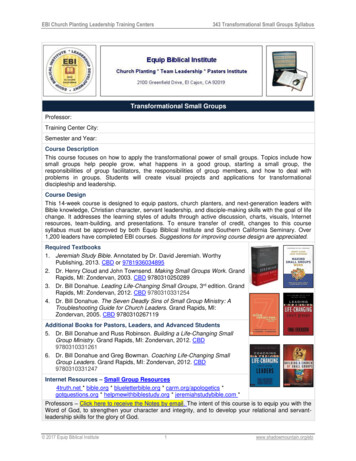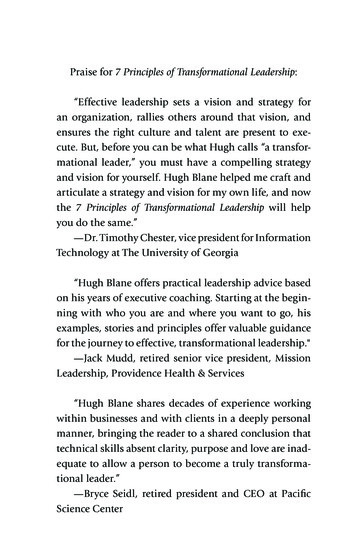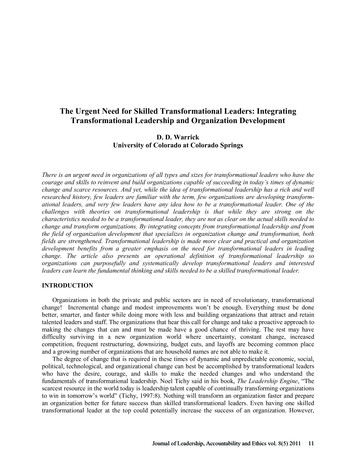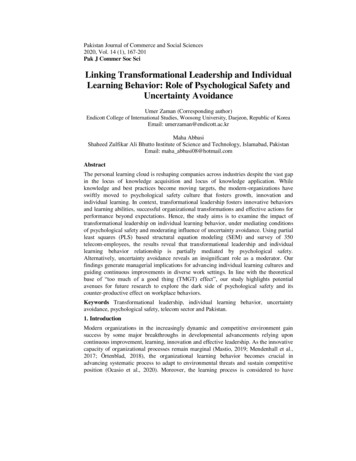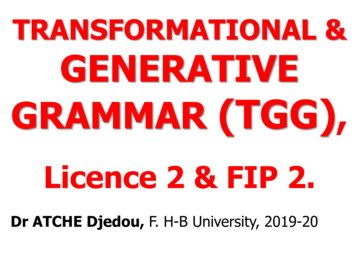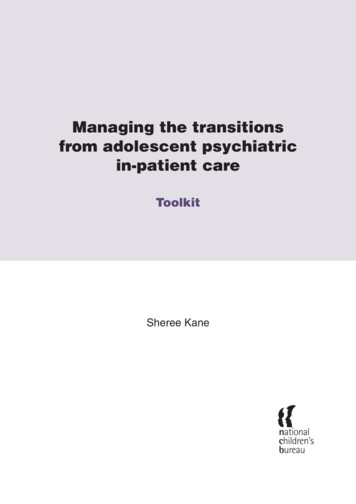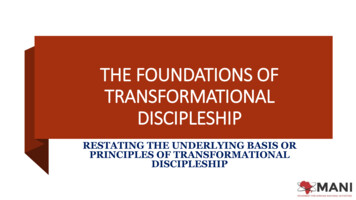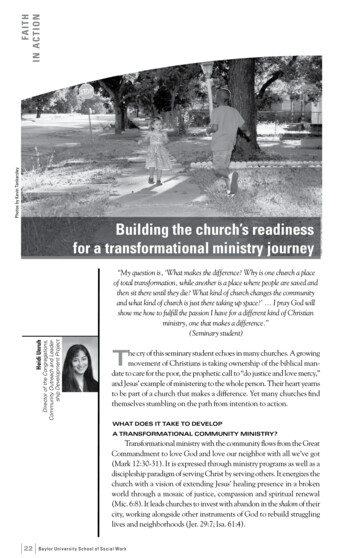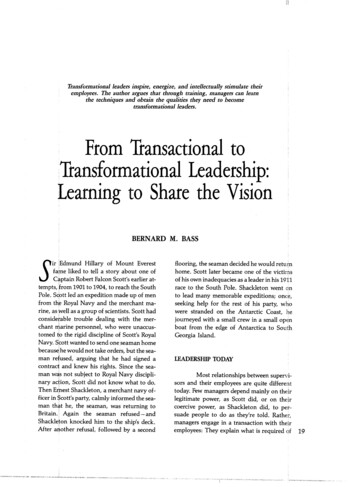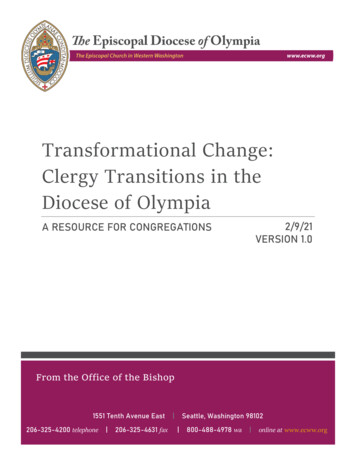
Transcription
Transformational Change:Clergy Transitions in theDiocese of Olympia2/9/21VERSION 1.0A RESOURCE FOR CONGREGATIONSFrom the Office of the Bishop1551 Tenth Avenue East Seattle, Washington 98102The Episcopal Diocese Of Olympia 1551 10th206-325-4200 telephone 206-325-4631 fax 800-488-4978 wa online at www.ecww.org
Transformational Change: Clergy Transitions in the Diocese of OlympiaFebruary 9, 2021TABLE OF CONTENTSForward . 3Spirituality in Transitions .4Congregational Development in Transitions. 5Congregational Ministry in Transition . 7Role of Clergy. 7Role of Wardens .8Role of Treasurer . 9Role of Vestry or Bishop’s Committee. 9Role of Whole Congregation . 10Role of Staff Members. 11Leave-taking . 12Mechanics of separation . 12Spirituality of Separation: Saying Goodbye Well . 14Timeline Overview . 16PIC versus Interim Timelines . 19Factors Influencing Discernment of Call Process Type . 20The Office of the Bishop’s Support in the Transition Process .22Transition Consultants .22Staff: Canon to the Ordinary .22Staff: Canon for Congregational Development and Leadership Formation . 23Staff: Canon for Diocesan Networking and Connections. 23Staff: Bishop Diocesan . 24Staff: Executive Assistant to the Office of the Bishop . 24Staff: Communications . 25Profile Committee .26Work of the Profile Committee .26Calling a Profile Committee .26Profile Committee Task Clusters .271
Transformational Change: Clergy Transitions in the Diocese of OlympiaFebruary 9, 2021Search Committee .29Work of the Search Committee .29Boundaries and Confidentiality.29Calling a Search Committee . 30Search Committee Task Clusters . 31Search Committee Q&A . 33Extending a Call . 34Vestry and Bishop’s Committee Deliberations . 34Letter of Agreement. 35Negotiating and Executing the Letter of Agreement . 36Announcing a Call . 36Transition Committee .37Appendix 1: Office of Transition Ministry Worksheet . 38Appendix 2: Clergy Salary Scale . 432
Transformational Change: Clergy Transitions in the Diocese of OlympiaFebruary 9, 2021ForwardThere may be no more crucial time in the life of a congregation than the transition from oneordained leader to the next.Those charged locally with overseeing this process have an extremely important task to say theleast. It is so important that leadership select people for this task that do not have an “ax to grind”or an agenda to see to, but instead are deeply spiritual people who have an open mind and heartand are willing to listen, both to the ways God is speaking to them, but also listening to others asthey tell of how God is speaking as well. The entirety of the process is important.From the second a priest announces they are leaving until the moment you welcome the newpriest in person, every step is vital to the next one, to the future, to the success of the process.Saying goodbye, and doing it well, is important not only for the leaving priest, but I would daresay just as equally important for the one yet unknown who will arrive sometime later.All of these moments, all of these acts, are culture changing acts, for good or ill. So, in this processwe strive for them to be healthy acts, good changes, enhancing the common good in ourcommunity. This is not a job, it is a “call,” and I think that distinction is so important. We are notdoing job interviews; we are assessing calls.I finally simply want to thank those of you who are answering your call to be part of this process.It is so important to our common life, it is a sacred act, and I cannot thank you enough foragreeing to do it. I also offer myself, my staff, and any resource we might offer to help youperform this task with as much excellence, attention, and devotion that is possible.The Rt. Rev. Gregory Rickel,Bishop, Diocese of Olympia3
Transformational Change: Clergy Transitions in the Diocese of OlympiaFebruary 9, 2021Spirituality in TransitionsChallenging situations are often the fertile ground for spiritual growth. As people face thechallenge of seeking a new priest leader to help develop their congregation’s spirituality andministry, spiritual challenges and new solutions may arise.Spiritual DilemmaExceptionalism“We can do this without help.”Spiritual QuestionHumilityHow can we learn to give and receivecare from others?False Urgency“We shouldn’t have to wait. Why is thistaking so long?”PatienceWhat spiritual practices help us modelthe expectation that Jesus will bepresent? How can we cultivate Easterhope?The Employment Search“We need to find someone who doesthe things our former priest did asquickly as possible.”DiscernmentWho does God need us to be with andminister alongside?(Individual) Pride“I know who our priest should be, orwhat qualities they would have.”Fellowship and ListeningWhat do I need to know to find a priestwho can pastor and teach all of us?Mission Pause“Let’s wait on anything important untilthe new priest comes.”Priesthood of All BelieversHow has Jesus already authorized youas leaders to reconcile, heal, andproclaim the Gospel?False Currencies“Do we even need a priest? We can doall that stuff cheaper.”Orders of MinistryHow are baptized people, deacons,priests and bishops more than thethings they do for us? What differentspiritual gifts do they add to thecommunity?All of these and other things thattrigger our anxiety, fear, sadness, andanger.PrayerHow am I asking Jesus to be a part ofthis moment?How am I inviting the Holy Spirit to bea part of my decision?How am I recognizing God in thepeople or things that I am seeing?4
Transformational Change: Clergy Transitions in the Diocese of OlympiaFebruary 9, 2021Congregational Development inTransitionsTransition isn’t a fallow time for ministry, but our developmental focus changes during transition.Transitions give congregations unique opportunities to focus on developmental opportunities.LeadershipFormationDevelopmental OpportunityDeepen and support the ministry of lay leaders: Lay leadership of vestry and BC meetings (FacilitationSkills) Explore and reflect on decision-making processes Develop new leaders as you work together to maintainand grow ministry without settled clergy.EvangelismEvangelism requires a clear understanding of the GoodNews. During transition, get good at telling the story ofwhat Jesus has been up to in your congregation andneighborhood: Explore your neighborhood and who isn’t at church Become clear about what your church does best andpractice telling people about it (Profile, Priest Search)StewardshipReview Finances and understand the impact of choicesmade over time.Talk openly about money and other shared resources.OutreachAs you explore who you are, talk with neighbors andministry partners about the impact your congregation hason the community. Share that with the congregation, widerdiocese, and prospective priests.FormationCongregational formation can be focused on spiritualquestions raised by transition: Grief/Loss How our neighborhood is changing Episcopal Church 101 Financial Stewardship5
Transformational Change: Clergy Transitions in the Diocese of OlympiaWorship Fellowship February 9, 2021Pastoral Preaching on the Spirituality of Transition (bysupply, interim, or lay leaders)Write prayers that the congregation says together onSunday or at meetings: Collect for Transition, Prayers ofthe PeopleIncorporate Transition announcements into the liturgyprayerfully.When the congregation is reflecting on where we’vebeen together, have fun. Gather people the way yourcongregation gathers people: Potlucks, Coffee Hour,Group Dinners, Virtual gatherings.Throw parties: When the priest leaves, when youachieve milestones in the process, when the new priestcomes.Plan fellowship activities to get interim and new clergyconnected more quickly.6
Transformational Change: Clergy Transitions in the Diocese of OlympiaFebruary 9, 2021Congregational Ministry inTransitionThe congregation and its leadership are the main drivers in a search. The role of the Office of theBishop is to support and consent or withhold consent if the bishop feels there is a genuine peril tothe congregation should the congregation move forward.This means the speed and quality of the search is mostly dependent on each member of thecongregation, especially formal leaders, doing their part.Role of ClergyThe role and stance of clergy is different depending on where a congregation is in a transition.Departing ClergyAs a congregation’s priest leaves, their job is to say goodbye in ways that help the congregation Celebrate mutual ministryDevelop healthy relationships with priestsPrepare administratively for the transitionIt’s normal for departing priests to become more reluctant to engage in long-term planning.Congregational leaders should begin taking a bigger role in that long-term planning and visionwork.Interim ClergyInterim Clergy are priests who carry out sacramental and pastoral duties of a congregation butmay not be called as the settled or permanent priest. Some interim clergy have special training inthe work of grief and loss or trauma. In the Diocese of Olympia, we do not currently requirespecial training or certification to serve in an interim role.In the Diocese of Olympia, we typically do not call “developmental interims.” Instead of an interimwho uses tools from congregational and organization development, we tend to recruit priests whofunction as chaplains or companions to the congregation while Transition Consultants workdirectly with folks on the process. Because the Transition Consultant is directly resourcing thecommittees, the Interim Priest does not participate in those committees or conversations at the BCor vestry level about candidates. If an interim priest is unsure about how to draw a particularboundary in a congregation, they may call the Canon to the Ordinary for advice.7
Transformational Change: Clergy Transitions in the Diocese of OlympiaFebruary 9, 2021Priest-in-Charge (PiC)Priests-in-Charge have the canonical authority of a Rector in a Parish or Vicar in a Mission. Unlikean interim, a priest-in-charge may be called as the Vicar or Rector. PiCs in the Diocese of Olympiatypically agree to a two-year period of Mutual Ministry including: First 6 months: Priest and people orient to mutual ministry togetherMonth 5/6: Work with Transition Consultant on Congregation-Wide Mutual MinistryAgreement Goal settingMonth 6-18: Congregation works with PiC to carry out Mutual Ministry GoalsMonth 18-24: Congregation and PiC work with Transition Consultant to developdiscernment process for calling a Vicar/Rector or seeking a new Vicar/RectorNewly Called PriestWhen you have called a priest and signed the Letter of Agreement, you will work with the dioceseto announce the happy news. The new priest may need time to prepare or move. When ministrybegins, the congregation can and should plan fellowship and trust-building events.The congregation and its members will be let down by the new priest if they expect: The priest to grow the church and add new families. - The priest helps the peoplegrow the church.The priest to double pledging units. - The priest helps people develop faithfulstewardship practices.The priest to know who is in the hospital. - The priest works with other ministers toidentify people in need of care and provide pastoral support.The priest will spend a lot of their time: Getting to know people in the congregationLearning what prayers, songs and patterns of worship feel “normal” to thecongregationLearning what people and groups do what ministries.Role of Wardens“At all Parish meetings, the Rector (or if there is none, a Warden) shall preside, unless the Rectordelegates this responsibility to a Warden. The Clerk of the Vestry shall act as Clerk of theMeeting.” - Diocese of Olympia Constitution and Canons; Canon 9, Section 1.c. See also MissionsCanon 11, Section 3.d.8
Transformational Change: Clergy Transitions in the Diocese of OlympiaFebruary 9, 2021During a period without a Rector/Vicar/Priest-in-Charge, the Canons give the wardens authoritythat is typically exercised by the priest. These include convening and chairing vestry or BCmeetings, managing hiring and staffing concerns, communicating about the Transition and otherimportant celebrations in the life of the congregation.When a warden must be reelected without a permanent priest present, the vestry or Bishop’sCommittee selects its warden(s).When a call is extended, the warden contacts the Canon to the Ordinary and typically negotiateswith the priest on behalf of the vestry with the assistance of the Office to the Bishop.Wardens are given this authority because they have important duties to carry out includinghelping the church call a new leader! Wardens aren’t in this alone. Other members of the vestryand BC, as well as the staff of the Office of the Bishop, are here to help.Role of TreasurerDuring the Transition, church Treasurers carry out their normal duties executing payments asdirected by the vestry or Bishop’s Committee. Treasurers play a critical role in assisting the vestryor Bishop’s Committee in developing a budget for the search. (See “Timeline Outline” for budgetdevelopment detail)Treasurers help the Profile Team by gathering information about the financial health of thecongregation. A treasurer is also one of the folks who signs some employment agreements withpriests, in part to affirm that the congregation is willing and able to pay the negotiatedcompensation or severance on behalf of the vestry or Bishop’s Committee.Role of Vestry or Bishop’s CommitteeVestries are the elected leaders of a parish. In transition time, the vestry stewards the resources ofthe congregation and ensures that the church continues to carry out its mission.Bishop’s Committees (BC’s) are the elected leaders of a mission. A bishop has the authority toappoint or remove members of a Bishop’s Committee, though that is not done without goodreason and great care. In transition time, the BC stewards the resources of the congregation andensures that the church continues to carry out its mission.In the Diocese of Olympia, vestries and Bishop’s Committees “charge” Profile and SearchCommittees. This means that the elected leaders find and appoint members to these teams andreceive regular reports (at monthly meetings minimally) about the work of the committees, even ifthey have not met. When charging a committee, the vestry or BC should indicate how thecommittee will know it’s work is finished.9
Transformational Change: Clergy Transitions in the Diocese of OlympiaFebruary 9, 2021After the work of the Profile and Search Committee is finished, the Search Committee willrecommend a single name with supporting materials supplied by the candidate for an up or downvote. The vestry or BC do not review other candidates’ materials or receive rankings. If the vestryor BC do not select the candidate, the warden(s) should contact the Canon to the Ordinary formore information on how to proceed. If the vote results in a call, the warden(s) contact the Canonto the Ordinary for a template of a Letter of Agreement and instructions on how to proceed.The vestry and Bishop’s Committee also have an important role as spiritual leaders. While we maynot think of our role as vestry or BC members as spiritual leadership, the congregation selectedyou because they trusted you to make faithful decisions on behalf of the community.During transition, friends and siblings in Christ may experience anxiety, fear, sadness, loss, grief,anger. Your critical role is to direct this energy in the healthiest possible direction. It’s normal tobe worried about how long the call is taking. If you try to resolve that energy by making hastydecisions, that isn’t healthy and may lead to an ineffective call. Instead, spiritual leaders in times oftransition direct that energy to places where it can be transformed into health!If someone is in grief about the loss of their relationship with their priest, consider asking them toshare their gratitude for the ministry they received in a letter.If someone approaches you as a vestry member about being on the Search Committee and thepriest hasn’t left yet, consider asking them to help plan the going away party, or help out thecommunity in a way that makes sense for them and hang onto their name for the months it willtake to get to the Search phase.Role of Whole CongregationThe most important thing a congregation can do in a time of transition is to love Jesus. Ourbaptismal ministry and call to love and reconcile the world is fully binding whether a priest isserving our congregation or not. Focusing on the core ministry of the congregation is helpful. Keepbeing the people of God in your neighborhood throughout the search for a new priest leader.Successful calls follow honest and earnest conversation about who we were, who we are now, andwho God is calling us to be. Each member from 0-120 years old answers those questions indifferent ways. Each answer is important and reflects the ministry Jesus is calling forth from thisgathered Body of Christ.Participation in surveys, conversations, fellowship, and worship all help the process reflectaccurate answers to those mission-critical questions: Who were we?Who are we now?Who is God calling us to be?10
Transformational Change: Clergy Transitions in the Diocese of OlympiaFebruary 9, 2021Role of Staff MembersTransition can be a particularly challenging time for staff. In years gone by, it was the custom thatchurch staff tender their resignations to the new priest who had the privilege of accepting orrejecting the resignation. That is less common today, though some congregations and clergy stillobserve the practice.Because staff members both are committed to the mission of the church and financially dependenton the congregation, their role is especially tough to navigate during transition time. Considerhow the vestry and BC are caring for staff during transition. Do we need to adjust work duties, hours or compensation to account for changing workduring the transition? How will we know how or when to change back?What is causing anxiety?If the priest was the main conduit of information between staff and the vestry/BC, howwill you learn what is happening in the lives and work of the staff?Staff members are excluded from roles on the vestry, BC, Profile Committee and SearchCommittee. This can be difficult, especially if staff are members of the congregation. The integrityof the church’s collective leadership is threatened by conflicts of interest or the appearance of aconflict of interest that may occur when staff participate in the selection of the person chargedwith overseeing them and holding them accountable for their work.11
Transformational Change: Clergy Transitions in the Diocese of OlympiaFebruary 9, 2021Leave-takingMechanics of separationDiscernment of a new callThis often happens quietly. Priests, like all ministers listen to the gathered Body of Christ andGod’s will for their lives and realize it’s time for them to take on some new mantle of ministry.Sometime this means a retirement. Other times, a priest may have exercised their gifts as fully asthey can but have come to realize they are not the leader to bring this people into God’s promisedland of health and spiritual renewal. Sometimes, some other member of the wider church calls apriest to a new adventure.When a priest is beginning to discern a new path for their priestly ministry, they should check inwith the Canon to the Ordinary for ideas about how to proceed with this vocational discernment.This conversation might include: Spiritual Questions: What is God asking of you? What are you running away from? Whatare you running towards?Revisit Vocational Questions: Is God calling you to use your gifts in new ways or newplaces?Practical Questions: How much money will you need to make? Where are you able tolive/move?As clearer answers form to these questions, it’s a good idea for a priest to make an appointmentwith the bishop to talk about the changing emotional and spiritual context of their ministry. Thismeeting isn’t generally about specific calls, but more about the bishop gaining pastoral context sothe Office of the Bishop can be as helpful as possible in ongoing discernment.Announcing a departureWhen a priest is sure it’s time to leave their role as Priest-in-Charge (Rector/Vicar) theannouncement happens in the following order: Priest informs the bishop. This may be via email or formal letter. Typically, these aretransmitted electronically. The bishop may offer advice. The bishop may connect the priestto specific staff for follow up and support.Priest informs wardens. This is typically done “face-to-face.” The wardens will need toknow before others because they have special duties in times of transition.Priest and wardens draft announcement to vestry/BC and whole congregation. Thisannouncement typically happens at times when groups meet. The vestry/BC learns at its12
Transformational Change: Clergy Transitions in the Diocese of Olympia February 9, 2021next meeting, the congregation learns at a Sunday worship service after the vestry/BCmeeting where leaders were informed.Plan email or mail distribution of the announcement. Not everyone will be in church. Makesure leadership has a plan for emailing, mailing, or calling folks who really want to knowthis important news but weren’t at church or the meeting.Letter of SeparationSaying goodbye, grieving, and living like we will die are all a part of Christian spirituality. A Letterof Separation spells out what the new relationship between the priest and soon-to-be-formercongregation will look like. For the past several years, the Office of the Bishop has includedsample text for the Letter of Separation in all rector and vicar agreements to ensure folks knowwhat to expect when the relationship ends.Separation Letters include Final Date of Employment, Final SundayCompensation: Any final compensation details including insurance, pension, use ordeparture from church owned housing etc.Property: Date for return of keys, documents, discretionary funds, and any other propertyowned by the churchBoundaries: Behavioral boundaries expected of departing priest, specify who may invitethe priest to return and under what conditions, specify any special celebrations or ministryactivities that will happen after the end date. [Events not specified in the agreement aregenerally not permitted by the bishop.]The wardens and priest negotiate the Letter of Separation. If cash payments, benefits, or housingrequire negotiation, the congregation’s treasurer and the Diocese of Olympia’s Canon to theOrdinary may be helpful resources.When the agreement has been negotiated, send the word document to the Canon to the Ordinary.The Canon for Governance and Diocesan Networking will review negotiated elements and anychanges made to the template to ensure compliance with employment law, canons, and diocesanpolicy. The Office of the Bishop will also review the document. The bishop reviews the documentwith special care for pastoral implications.When the bishop and vestry or BC have approved the document, the Canon to the Ordinary willgather the signatures electronically and send executed copies to the signatories.13
Transformational Change: Clergy Transitions in the Diocese of OlympiaFebruary 9, 2021Spirituality of Separation: Saying Goodbye WellMake sense of what happened.When the incumbent priest is still with the congregation, it’s good to talk about the time spenttogether and ministry accomplished. Some of that will be very happy! Some of that will hurt.Name and document how the priest and congregation faced real challenges, thrived, celebratedtogether. You will remember challenges you faced and perhaps even dissatisfaction with some ofthe outcomes. Create spaces where people speak openly about their experience of the priest with the priestin the room. Consider appreciative questions like: What ministries that we did together areyou most proud of? What challenges did we face together? How did we face them? Thepriest’s role is to listen and accept the gift of feedback from the congregation. Thecongregation’s role is to begin to get braver in telling its story of the work without theclergyperson’s narrative.Use preaching and other communications tools to communicate “the story of the last #years together.” Include stakeholder voices other than the cleric who will remain in thecongregation after the transition. This helps provide stability.Say GoodbyeSaying goodbye is a process and a skill. People do it differently. Some people foul the nest. They can’t be ok leaving the relationship unless there is aprecipitating crisis. Some people say, “we will see each other around.” They may be denying the reality of theirown grief. They probably won’t be seeing each other as much. Some people just detach. Today people call this “ghosting”. These folks can’t deal with theemotional reality so they just don’t show up if there will be goodbyes.Clergy transition gives us a chance to do something different. We are invited to be vulnerable andhonest. It will be joyful and sad. It will be real. Focus on thanksgiving. Leaders should be saying, “I am so grateful that ” more than usual. Throw a party. Make a symbolic, liturgical act out of the departure. Spend energy onmaking it authentic to how your community celebrates. Engage a large swath of peoplefrom the congregation. Give a present. If the Celebration of Mutual Ministry was theBaptism, this is the Wake and Funeral. These are Resurrection liturgies.Reset the BoundariesThe Letter of Agreement is a bit like a prenuptial agreement. It lays out the expectations for howwe will live together. It also acknow
Transformational Change: Clergy Transitions in the Diocese of Olympia February 9, 2021 . 1 . . and are willing to listen, both to the ways God is speaking to them, but also listening to others as they tell of how God is speaking
